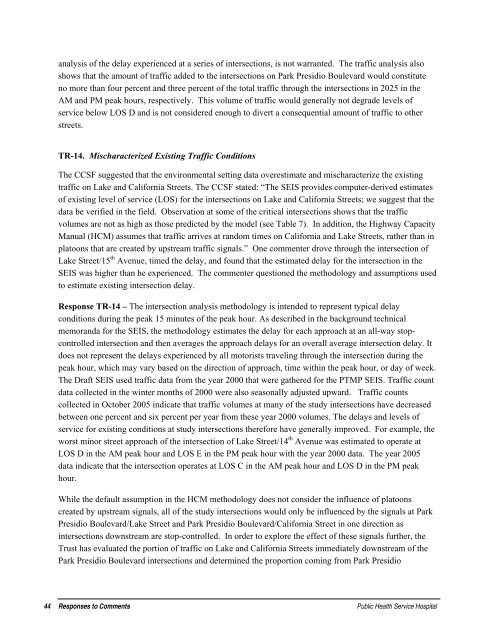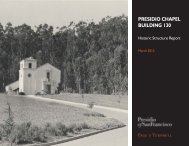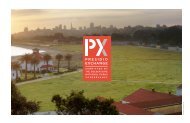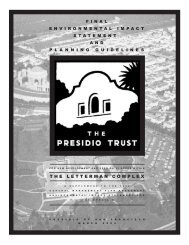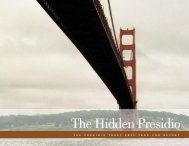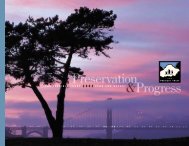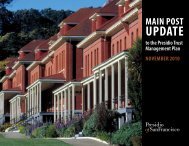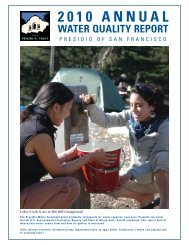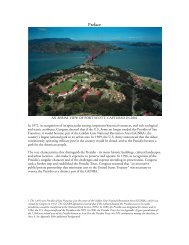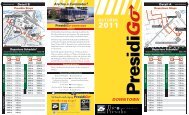Response to Comments - Presidio Trust
Response to Comments - Presidio Trust
Response to Comments - Presidio Trust
Create successful ePaper yourself
Turn your PDF publications into a flip-book with our unique Google optimized e-Paper software.
analysis of the delay experienced at a series of intersections, is not warranted. The traffic analysis alsoshows that the amount of traffic added <strong>to</strong> the intersections on Park <strong>Presidio</strong> Boulevard would constituteno more than four percent and three percent of the <strong>to</strong>tal traffic through the intersections in 2025 in theAM and PM peak hours, respectively. This volume of traffic would generally not degrade levels ofservice below LOS D and is not considered enough <strong>to</strong> divert a consequential amount of traffic <strong>to</strong> otherstreets.TR-14. Mischaracterized Existing Traffic ConditionsThe CCSF suggested that the environmental setting data overestimate and mischaracterize the existingtraffic on Lake and California Streets. The CCSF stated: “The SEIS provides computer-derived estimatesof existing level of service (LOS) for the intersections on Lake and California Streets; we suggest that thedata be verified in the field. Observation at some of the critical intersections shows that the trafficvolumes are not as high as those predicted by the model (see Table 7). In addition, the Highway CapacityManual (HCM) assumes that traffic arrives at random times on California and Lake Streets, rather than inpla<strong>to</strong>ons that are created by upstream traffic signals.” One commenter drove through the intersection ofLake Street/15 th Avenue, timed the delay, and found that the estimated delay for the intersection in theSEIS was higher than he experienced. The commenter questioned the methodology and assumptions used<strong>to</strong> estimate existing intersection delay.<strong>Response</strong> TR-14 – The intersection analysis methodology is intended <strong>to</strong> represent typical delayconditions during the peak 15 minutes of the peak hour. As described in the background technicalmemoranda for the SEIS, the methodology estimates the delay for each approach at an all-way s<strong>to</strong>pcontrolledintersection and then averages the approach delays for an overall average intersection delay. Itdoes not represent the delays experienced by all mo<strong>to</strong>rists traveling through the intersection during thepeak hour, which may vary based on the direction of approach, time within the peak hour, or day of week.The Draft SEIS used traffic data from the year 2000 that were gathered for the PTMP SEIS. Traffic countdata collected in the winter months of 2000 were also seasonally adjusted upward. Traffic countscollected in Oc<strong>to</strong>ber 2005 indicate that traffic volumes at many of the study intersections have decreasedbetween one percent and six percent per year from these year 2000 volumes. The delays and levels ofservice for existing conditions at study intersections therefore have generally improved. For example, theworst minor street approach of the intersection of Lake Street/14 th Avenue was estimated <strong>to</strong> operate atLOS D in the AM peak hour and LOS E in the PM peak hour with the year 2000 data. The year 2005data indicate that the intersection operates at LOS C in the AM peak hour and LOS D in the PM peakhour.While the default assumption in the HCM methodology does not consider the influence of pla<strong>to</strong>onscreated by upstream signals, all of the study intersections would only be influenced by the signals at Park<strong>Presidio</strong> Boulevard/Lake Street and Park <strong>Presidio</strong> Boulevard/California Street in one direction asintersections downstream are s<strong>to</strong>p-controlled. In order <strong>to</strong> explore the effect of these signals further, the<strong>Trust</strong> has evaluated the portion of traffic on Lake and California Streets immediately downstream of thePark <strong>Presidio</strong> Boulevard intersections and determined the proportion coming from Park <strong>Presidio</strong>44 <strong>Response</strong>s <strong>to</strong> <strong>Comments</strong> Public Health Service Hospital


